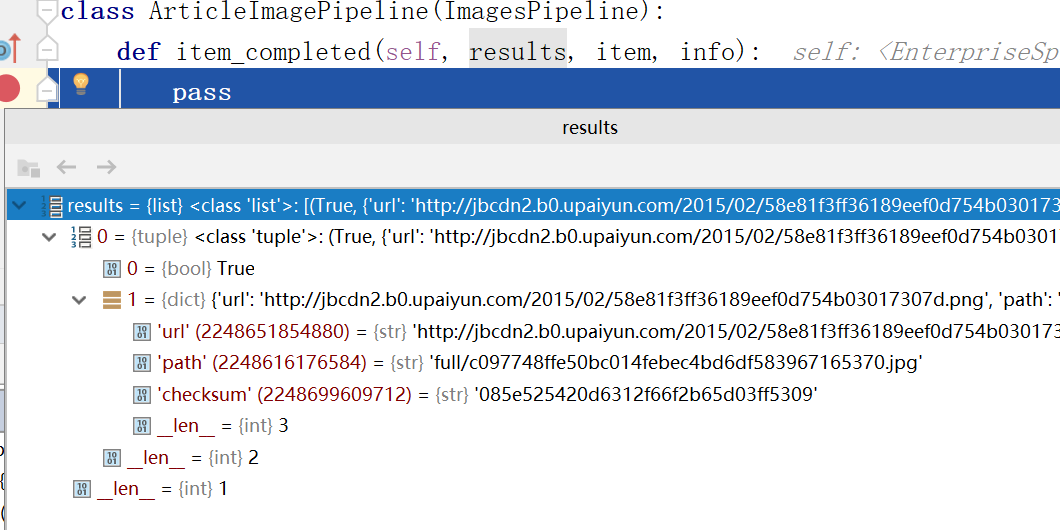爬取伯乐在线文章(四)将爬取结果保存到MySQL
讨论QQ:1586558083
正文
Item Pipeline
当Item在Spider中被收集之后,它将会被传递到Item Pipeline,这些Item Pipeline组件按定义的顺序处理Item。
每个Item Pipeline都是实现了简单方法的Python类,比如决定此Item是丢弃而存储。以下是item pipeline的一些典型应用:
- 验证爬取的数据(检查item包含某些字段,比如说name字段)
- 查重(并丢弃)
- 将爬取结果保存到文件或者数据库中
编写item
在items.py中进行编写
class JobBoleArticleItem(scrapy.Item): title = scrapy.Field() create_date = scrapy.Field() praise_num = scrapy.Field() collect_num = scrapy.Field() comment_num = scrapy.Field() front_image_url = scrapy.Field()
编写之后在提取文章逻辑里面进行实例化
def parse_detail(self,response): print("目前爬取的URL是:"+response.url) #提取文章的具体逻辑 article_item = JobBoleArticleItem() front_image_url = response.meta.get("front_image_url", "") # 获取文章标题 title = response.css('.entry-header h1::text').extract()[0] # 获取发布日期 create_date = response.css('.entry-meta .entry-meta-hide-on-mobile::text').extract()[0].strip().replace("·", "") # 获取点赞数 praise_num = response.css('.vote-post-up h10::text').extract()[0] # 获取收藏数 collect_num = response.css('.post-adds .bookmark-btn::text').extract()[0].split(" ")[1] collect_match_re = re.match(r'.*?(\d+).*', collect_num) if collect_match_re: collect_num = int(collect_match_re.group(1)) else: collect_num = 0 # 获取评论数 comment_num = response.css('.post-adds .hide-on-480::text').extract()[0] comment_match_re = re.match(r'.*?(\d+).*', comment_num) if comment_match_re: comment_num = int(comment_match_re.group(1)) else: comment_num = 0 content = response.css('div.entry').extract()[0] article_item["title"] = title article_item["create_date"] =create_date article_item["praise_num"] = praise_num article_item["collect_num"] = collect_num article_item["comment_num"] = comment_num article_item["front_image_url"] = front_image_url yield article_item
最后调用yield article_item之后,article_item会传递到pipelines.py里面
编写pipelines
在pipelines.py文件中模板已经写好,但是如果要使之生效,需要修改settings.py文件,将ITEM_PIPELINES的注释去掉

在pipelines.py里面打断点进行调试,看article_item是否能传递尽来

如何将图片保存到本地
继续修改item,scrapy提供了一些方法,方便快速开发,修改settings.py
ITEM_PIPELINES = { 'EnterpriseSpider.pipelines.EnterprisespiderPipeline': 300, 'scrapy.pipelines.images.ImagesPipeline': 1, } IMAGES_URLS_FIELD = "front_image_url" project_dir = os.path.abspath(os.path.dirname(__file__)) IMAGES_STORE = os.path.join(project_dir, "images")
'scrapy.pipelines.images.ImagesPipeline': 1-------设置scrapy自带的普票保存方法,后面设置数字是流经管道的顺序,数字小的先流经
IMAGES_URLS_FIELD = "front_image_url"------从item中提取图片的URL,前面的IMAGES_URLS_FIELD是固定写法
project_dir = os.path.abspath(os.path.dirname(__file__)):获取当前项目的路径
IMAGES_STORE = os.path.join(project_dir, "images"):设置图片存储的路径
此时运行我们的main看是否能将图片保存

报错,没有PIL这个模块,这个是与图片文件相关的库,我们没有按照,所以报错,在虚拟环境中安装PIL模块
(scrapyenv) E:\Python\Envs>pip install -i https://pypi.douban.com/simple pillow

安装之后重新运行程序,此时又报另一个错误

这个因为item传递到pipline的时候,下面的front_image_url 会被当做数组处理,但是我们在业务逻辑处理时候只是把他当做一个值进行处理
IMAGES_URLS_FIELD = "front_image_url"
修改业务处理逻辑
article_item["title"] = title article_item["create_date"] =create_date article_item["praise_num"] = praise_num article_item["collect_num"] = collect_num article_item["comment_num"] = comment_num article_item["front_image_url"] = [front_image_url] yield article_item
修改完之后在运行程序,此时爬取的图片成功保存到images文件夹下面
既然图片已经保存到本地了,那么是否可以提取出路径,是否能把item里面的front_image_url与本地路径绑定在一起,此时我们需要定义一个自己pipeline,重载ImagesPipeline 中的item_completed
方法。
class ArticleImagePipeline(ImagesPipeline): def item_completed(self, results, item, info): pass
此时在修改settings.py文件,设置问我们自定义的图片处理pipeline
ITEM_PIPELINES = { 'EnterpriseSpider.pipelines.EnterprisespiderPipeline': 300, # 'scrapy.pipelines.images.ImagesPipeline': 1, 'EnterpriseSpider.pipelines.ArticleImagePipeline': 1, }
打断点进行调试

重写item_completed方法
class ArticleImagePipeline(ImagesPipeline): def item_completed(self, results, item, info): for ok, value in results: image_file_path = results["path"] item["front_image_url"] = image_file_path return item
保存到JSON
class JsonWithEncodingPipeline(object): def __init__(self): self.file = codecs.open('article.json', 'w', encoding='utf-8') def process_item(self,item,spider): lines = json.dumps(dict(item), ensure_ascii=False) + "\n" self.file.write(lines) return item def spider_closed(self,spider): self.file.close()
保存到MySQL
同步保存
class MysqlPipeline(object): def __init__(self): self.conn = MySQLdb.connect('127.0.0.1', 'root', '123456', 'article', charset='utf8', use_unicode=True) self.cursor = self.conn.cursor() def process_item(self,item,spider): insert_sql = ''' insert into jobbole(title,create_date,front_image_url,praise_num,collect_num,comment_num,url,url_object_id) VALUES (%s, %s, %s, %s, %s, %s, %s, %s) ''' self.cursor.execute(insert_sql, (item['title'], item['create_date'], item["front_image_url"], item["praise_num"], item["collect_num"], item["comment_num"], item["url"], item["url_object_id"])) self.conn.commit()
异步保存
class MysqlTwistedPipeline(object): def __init__(self, dbpool): self.dbpool = dbpool @classmethod def from_settings(cls, settings): dbparams = dict( host=settings['MYSQL_HOST'], db=settings['MYSQL_DBNAME'], user=settings['MYSQL_USER'], password=settings['MYSQL_PASSWORD'], charset='utf8', cursorclass=MySQLdb.cursors.DictCursor, use_unicode=True, ) dbpool = adbapi.ConnectionPool("MySQLdb", **dbparams) return cls(dbpool) def process_item(self,item,spider): #使用twisted将mysql插入变成异步插入 query = self.dbpool.runInteraction(self.db_insert, item) query.addErrback(self.handler_error, item, spider) def handler_error(self,failuer,item,spider): #处理异步插入的异常 print(failuer) def db_insert(self,cursor,item): insert_sql = ''' insert into jobbole(title,create_date,front_image_url,praise_num,collect_num,comment_num,url,url_object_id) VALUES (%s, %s, %s, %s, %s, %s, %s, %s) ''' cursor.execute(insert_sql, (item['title'], item['create_date'], item["front_image_url"], item["praise_num"], item["collect_num"], item["comment_num"], item["url"], item["url_object_id"]))




【推荐】国内首个AI IDE,深度理解中文开发场景,立即下载体验Trae
【推荐】编程新体验,更懂你的AI,立即体验豆包MarsCode编程助手
【推荐】抖音旗下AI助手豆包,你的智能百科全书,全免费不限次数
【推荐】轻量又高性能的 SSH 工具 IShell:AI 加持,快人一步
· 10年+ .NET Coder 心语,封装的思维:从隐藏、稳定开始理解其本质意义
· .NET Core 中如何实现缓存的预热?
· 从 HTTP 原因短语缺失研究 HTTP/2 和 HTTP/3 的设计差异
· AI与.NET技术实操系列:向量存储与相似性搜索在 .NET 中的实现
· 基于Microsoft.Extensions.AI核心库实现RAG应用
· 10年+ .NET Coder 心语 ── 封装的思维:从隐藏、稳定开始理解其本质意义
· 地球OL攻略 —— 某应届生求职总结
· 提示词工程——AI应用必不可少的技术
· Open-Sora 2.0 重磅开源!
· 字符编码:从基础到乱码解决